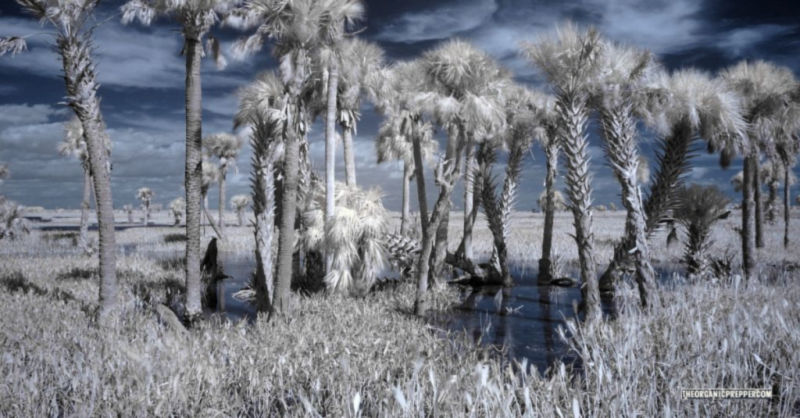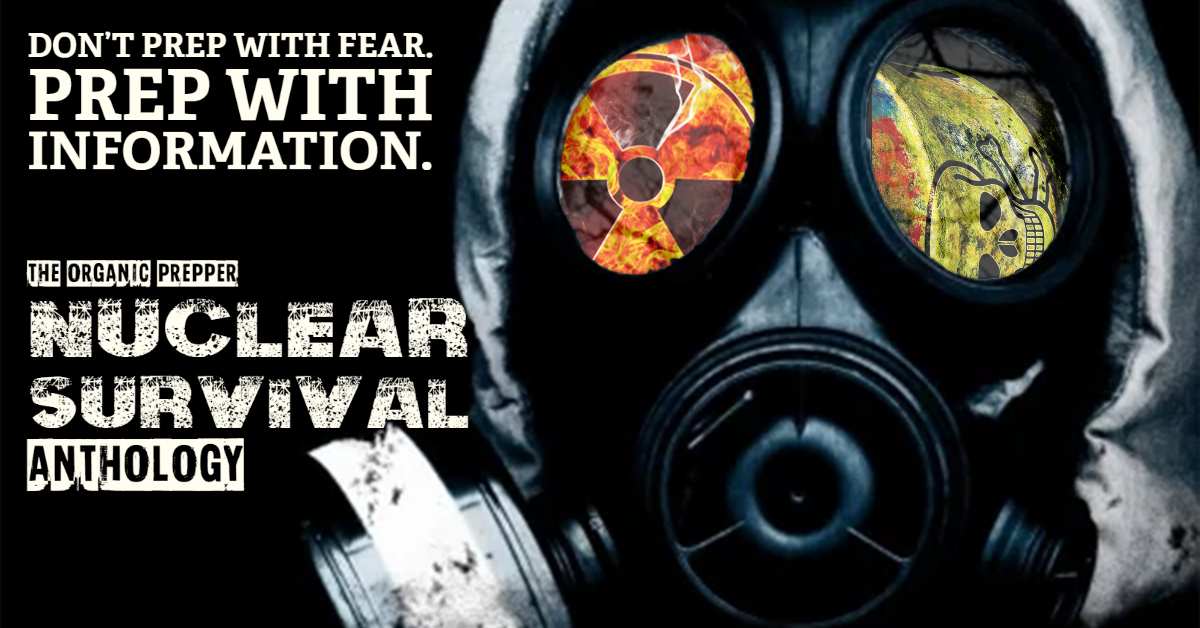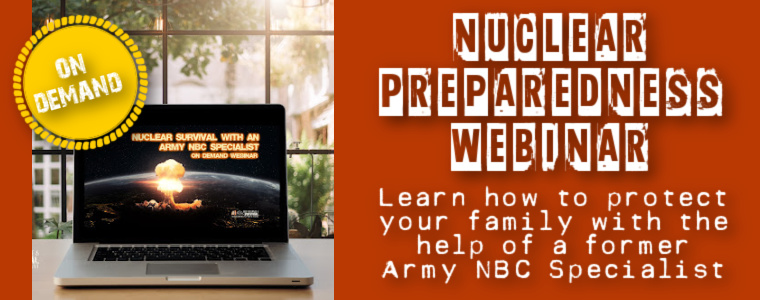If you're new here, you may want to subscribe to my RSS feed. Thanks for visiting!
By the author of The Faithful Prepper and Zombie Choices.
We’ve covered nuclear war a bit in the past here at The Organic Prepper, but as I’ve pointed out before, I believe that it is high time that you buckle down and get serious about this genuine threat. People fear what they don’t understand, and a large part of the fear involved with nuclear weapons is that they are a mysterious topic to the average American.
Nuclear weaponry? Isn’t that something from The Cold War? Why do we have to worry about that now? Hollywood, Carl Sagan, and others have most certainly done their part to popularize a number of nuclear weaponry myths. But that’s what I’d like to take a look at today.
What are the most popular myths out there involving nuclear war? Perhaps, if we can help to dispel some of these, we can help people to realize that A) nuclear war is survivable, B) there are action steps we can take to protect ourselves, and C) in the event of a nuclear strike, we won’t find ourselves absolutely clueless.
We put together a quick anthology of all our nuclear preparedness and information articles that you can get here and name your own price. If times are tough, pay as little as you like, and if you want to support the site more, pay as much as you like. This is information available on the website in an easily printable format so you can get a hard copy immediately.
Let’s look at one of the most common:
Myth – A nuclear exchange will result in a nuclear winter where the sky will darken and temperatures will plummet.
This theory began in 1982 when German environmentalist Paul Crutzen conceived the idea and gained a lot of momentum as time went on, largely thanks to Carl Sagan. Interestingly enough, throughout The Cold War, there was a massive push by the Soviets to change the common American’s perception of a wide range of issues. Disarmament was one of these issues Soviets discretely tried (and succeeded) in impact within the United States. (Read page 82 of John Stormer’s None Dare Call It Treason.)
KGB defector Sergei Tretyakov actually stated in 2000 that the KGB was responsible for the entire nuclear winter hoax.
So, if Soviet scientists pushed the notion of a nuclear winter, the next question is this: Why?
Because it spread fear in America. Nobody wants to fight a war they can’t win, and terror gets people to quit thinking rationally. If you can spread the idea that a nuclear exchange will only hurt yourself because of an inescapable nuclear winter, then you can help people to begin to do the mental gymnastics necessary to think that laying down their own rifles will cause their opponent (with a rifle) to magically become harmless.
Of course, in this case, we’re talking about nuclear weaponry, but the point remains: the nuclear disarmament movement was largely sponsored by the Soviets and was based on a disinformation campaign.
Cresson Kearney’s thoughts
According to Cresson Kearney’s excellent book Nuclear War Survival Skills (he actually received the Army’s Decoration for Distinguished Civilian Service in 1972 because of how many Americans he helped prepare for nuclear war), the idea of a nuclear winter is quite simply untrue.
A nuclear strike would cause a temperature reduction (perhaps of up to 20 degrees), but this would only last for a number of days. It wouldn’t result in a season-long time of frigid temperatures and the death of plant life.
What Kearney points out would be the real threat after a nuclear strike is the destruction of the supply chain. Farmers would not be growing food, vital supplies would not be getting shipped out to where they’re needed, and all imports would likely be halted as well.
The true threat isn’t death from freezing from a nuclear winter, nor is it death by starvation from crops not growing from nuclear winter. The true threat is radioactive fallout and then starvation from supply chain destruction. (Make sure you read our free QUICKSTART Guide on building a 3-layer food storage system!)
Is nuclear winter a myth?
This is in contrast to the leftist media that seems to almost be hoping for a nuclear winter (to combat “climate change,” of course).
After Hiroshima and Nagasaki, we didn’t see a nuclear winter scene play out over the following years. Admittedly, however, these were air bursts rather than surface detonations.
And let’s not forget about the creation of the Tsar Bomba, the largest nuclear weapon ever created (that we know of). First tested by Russia in 1961, the Tsar Bomba was 1570x more powerful than Hiroshima and Nagasaki combined. Granted, the Tsar Bomba test was performed in the air (at 13,000 feet) and the shockwave reflecting from Earth kept the explosion from reaching the ground, so the amount of radioactive fallout wasn’t anywhere near what it would have been had the bomb been detonated on the ground, but it is something to think about. All brick and wooden buildings within 34 miles of ground zero were completely destroyed, however.
Also, to be consistent, let’s not forget that Bill Gates currently has a plan to block out the sun by spraying particulates into the air. Admittedly, none of the scientists involved in the program know whether or not their experiment will work or not, but it does stand to reason that if Gate’s particulates could result in cooler temperatures, a nuclear weapon could as well.
For how long though, is the question.
Kearney’s book was published in 1986, well over two decades after the Tsar Bomba was detonated. The whole earth knew when the Tsar Bomba was tested as well. It was no secret. I’m not even sure it would be possible to keep a Tsar Bomba explosion secret. Kearney most certainly had to have taken a Tsar Bomba-type ground explosion into his research when he came to the final conclusion that nuclear winter was a mythical component of a nuclear exchange.

Personally, and I’m no physicist, I think that what Kearney says makes the most sense.
I honestly don’t think that a nuclear winter is something that people need to concern themselves with. I believe that nuclear fallout would be a much bigger concern, and, really, as long as you are preparing your family with food/water, off-grid heat, and warm clothing, you would be about as prepped as was possible for a nuclear winter perchance Kearney was wrong.
What are your thoughts, though? Is there more you can add to the conversation? Let us know in the comments below.
About Aden
Aden Tate is a regular contributor to TheOrganicPrepper.com and TheFrugalite.com. Aden runs a micro-farm where he raises dairy goats, a pig, honeybees, meat chickens, laying chickens, tomatoes, mushrooms, and greens. Aden has two published books, The Faithful Prepper and Zombie Choices. You can find his podcast The Last American on Preppers’ Broadcasting Network.


















24 Responses
I’m opting to get my supply of radioactive iodine up to date!!!
I’d like to know if those over 40 should take potassium iodide. I’m over 40, and I would want to. Officially they say that those over 40 are at extremely low risk of developing thyroid cancer as a result of exposure. I’ve known two women well over 40 who had thyroid cancer, but not from a nuclear blast. I read that older people are more likely to have severe allergic reactions, but also that allergic reactions were usually mild. I ordered enough from Swanson for my daughter, me, our dog, and three cats for ten days. It just doesn’t sound right that those over forty don’t need it.
IF you had the time, is there any way to cover garden areas to protect them from fallout?
Maybe a smaller scale like raised beds or metal containers.
How long would the soul be unusable ?
Have you thought of one of those inexpensive green houses you can find on Amazon, Lowes, etc?
Even covering raised beds with tarps should help keep the fall out off of the soil. Be sure to carefully sweep off the dust into a container before you remove the cover from the raised bed.
Part of the theory of nuclear winter is partially based on a large scale nuclear exchange. In the event of a large number of ground level detonations, it is theorized that enough particulate ash created by the blasts would enter the upper atmosphere and stay aloft for months if not years. A natural phenomenon that supports this theory was the eruptions of Mounts Mayon and Tambora in the early 1800s. The year following the Tembora eruption was almost a full degree cooler world wide. If a similar amount of debris and ash were lofted to the upper atmosphere in a nuclear exchange, there could be a significant cooling which could impact yearly harvests worldwide.
However, I do agree that the more immediate concern would be the total shutdown of the supply change and perhaps fallout depending on where you are and where and when the exchange takes place.
Look up “The good news about nuclear destruction” Great article and video. Excellent info.
When it comes to nuclear war, most of what we see/hear is only speculation, theory, or myth. Fallout for example, depends a lot on whether we are seeing ground bursts, or air bursts. Neutron bombs may well change the overall effects. One nuke into Yellowstone , or another super volcano ( I think there are about 20 of them) could trigger an ELE. The last 80 years have seen a lot of improvements? in nuclear weapons, including “clean” bombs? We, as the average person, aren’t privy to the developments and specifics of the advancements that our governments have made. There was even a theory at one time that a nuclear weapon could actually wind up setting the atmosphere on fire. Although this possibility was later calculated to have a very minute chance of happening, we still cannot discount what multiple nuclear explosions might produce.
What is not theory, speculation or myth is the FACT that nuclear weapons produce EMPs. The destruction of our power grid, and infrastructure is pretty much guaranteed, without any other effects of a nuclear exchange.
Nuclear bombs can and will set the atmosphere on fire. Soon after Taiwan is invaded the USA will be nuked by Russia. All of California, New York, Florida, and Las Vegas will be gone in less than one hour. Christians, read the below prophecies and ask the Holy Spirit if they are true or not.
https://www.handofhelp.com/vision_1.php
https://www.handofhelp.com/vision_36.php
I think an emp caused by an air burst would be a likely scenario. Physical infrastructure left mostly intact, with the civilian population almost entirely destroyed within a year.
The oil, minerals, farmland and other valuable assets will be intact, for whoever ends up “winning.” No viable opposition left, just walk in and scoop it all up.
Lets not find out, eh?
C’mon brother. It would at least make life real interesting…..for about 18 minutes of flight time.
Honestly, I’m with you. I’d rather not find out. But this slow death by a thousand cuts that we’re suffering through right now isn’t a lot better. A collapsed economy, crushed by inflation, shortages, supply chain issues, food scarcity isn’t really that much fun to look forward to either.
What? Lockdowns, mask mandates, social distancing/isolation from the Camp Covidians, empty shelves, record gas prices, inflation, crime and more . . . that is not fun to watch?? 😉
Nope, not fun to watch. But what I watched in 2020 and am now watching with glee is Gold and Silver going up. Gold made an all time new high yesterday. I’m loving that and I hope it goes a LOT higher.
Let’s just say that anyone living near a military target, such as San Diego Bay, Miramar Air Base, or Camp Pendleton in San Diego County is going to be in a world of hurt. In a military attack, such as what happened at Pearl Harbor in WWII, the objective is to take out as many military bases and locations of military interest to maximize the other “team’s” inability to fight back, not destroy civilians and their property. Civilian targets are not the primary targets.
Yes, and any place in the US that is capable of launching any kind of rocket is a target as well. Many key sites will very likely be on the receiving end of more than one, to assure they are not capable of functioning.
There has been more than 2000, that is two thousand nuclear weapons used. There are a few people that have been in the blast radius of more than one bomb, and one of them lived to be 91.
The Nevada test site is located about 100km from Las Vegas, and over the years about 960 nuclear bombs have been exploded at the NTS, 100 above ground, the rest below, and Las Vegas is still a somewhat normal town.
Here is the list of US nukes that have been detonated, https://nuke.fas.org/guide/usa/nuclear/209chron.pdf
If that didn’t make a nuclear winter, I don’t think there will be one.
As James said, ground bursts would mirror volcanic explosions and the amount of particulates in the air. I think it would really depend on how widespread the use of nukes was.
In the end I don’t worry about nuclear winter any more than I do a major volcanic eruption that pumped enough dust into the air to drop the temp a degree or two. It could happen, but I already have a year with no summer factored in as much as I can.
I was thinking about a nuke into Yellowstone the other day. If you were going to lose and knew it, and you wanted to mske life hell for those who survived a couple nukes into some super volcanoes would make a statement.
Depending on where you live radiation may be a more likely threat.
The impact on the supply chain will be a bigger immediate and long term threat.
I have potasium iodate around. I’m over 40 and I’ll be taking it. Will it help? Maybe. Will it hurt? Probably not. My theory is you never know who is going to be affected so you may as well do everything you can to make sure everyone survives. Plus, we’ve seen the experts be wrong many times. I’m about done with the “experts” to be honest.
Cresson Kearney’s book is definitely worth reading., and it is based on hard science. For most people, having an underground shelter is probably the best and easiest to implement.
Here’s an interesting site if you want to do some experimenting with visualization of a certain area: https://nuclearsecrecy.com/nukemap/
The Nuclear Winter paper was basically a very amateurish fraud. The earth atmosphere model in the paper used assumed a non rotating earth. Someone who actually could do the math (Sagan could not) published a paper a few months later showing that even a simple earth rotation model made “Nuclear Winter” go away. Saga had a reputation in professional astronomy as being a crap scientist but a fantastic self publicist.
Lots of other BS put out by the Nuclear Disarmament people at the time. You only get lots of long term fall out with a ground burst. Air burst very little long term. Apart from sneak attack first strike on silos and bunker digging all targeted warheads are air-burst. Ground bursts are a waste of effort.
The failure rate in a hostile environment was always going to be 70% to 90%. For strategic. Much lower for tactical. Some strategic warheads might end up in weird places but not many would get through to target after the first half dozen air-bursts in a region. Not EMP. Other exotic physics.
Knew a guy who was pissed off that his unit did not get to fire a Davy Crockett in Nevada back in the early 1960’s. Another unit got to make the big boom. One of those high altitude air drop test detonations in Nevada had a camera crew filming about 30K feet below on the ground at the aim point in the desert. The crew members lived into their 80’s.
Lots of things to be very worried about at the moment, its very 1983/1863 this week, but the “Anti-Nuke” made up BS is not one of them. Its the heat flash thats the really nasty problem for those close in and line of sight. And the shock wave if way too close. But thats about it. All the catastrophic problems from multiple detonations (very low probability) are infrastructure and psychological.
Also, Russia always had a very different Nuclear Weapon use doctrine. Did not buy into MAD during the Col War and now it is Escalate to Deescalate. A single tac nuke as a demonstration they are serious. Until last week the probable target was the ABM radar in Poland. Now? With the Russian army heading toward a terrible defeat. Who knows.
Thats what I’m worried about.
Nothing we can do about it from our position anyway, so I guess we’ll just have to wait and see.
Cresson Kearney’s book is available in used condition for around $10 from Alibris.com. I just bought one.
I worry far more about radioactive fallout than I do about nuclear winter.
The Cresson Kearney book is also here. In the internet archive. Can be downloaded as a PDF.
https://archive.org/details/NuclearWarSurvivalSkills_930/page/n15/mode/2up
You can find a lot of interesting stuff in the Internet Archive. Some of it does not show up in their search. Try google to find the difficult to find stuff.